
|
Feedback Form

ROAMERS IN THE BUILT ENVIRONMENT

Mike Fox, Deputy Headteacher of Kings Rise Primary School, Kingstanding, Birmingham explains how Roamer played a major part in the school's curriculum development.
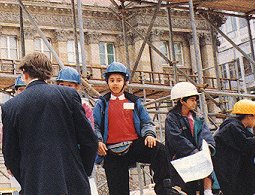
Over the last four terms, we have built a very good working relationship with B.E.E.P. (Built Environment Education Project) which is based at Brooklyn College, Birmingham. Many of our children have been involved in projects aimed to enhance their awareness of the local environment.
In the summer term, we were invited to take part in the Education Festival in Birmingham, which was planned for early October. This appeared to present a very good focus for the planned development of our technological curriculum. So was born the topic "Going Places".
We planned a cross-curricular topic for two Year 4 classes with the aim of promoting skill development through the delivery of National Curriculum programmes of study.
The programme of work had a strong technological and geographical focus. One of our major intentions was to demonstrate how technology could be integrated across the curriculum. We wished to give our pupils an opportunity to take part in a wide range of activities whilst at the same time taking into account their individual needs and abilities. We also intended to produce a resource that could be used in other classes within the school.
The Topic Web and associated pupil activity sheets gives a clearer picture of the work that was planned and delivered during the first half term.
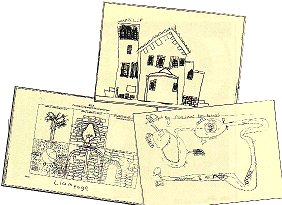 |
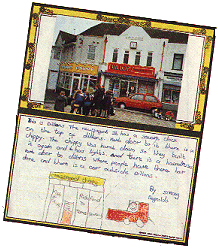 |
Our starting point was the school and journeys "to and from". We embarked on a number of walks which involved field sketching, photography, tape recording and generally encouraging the children to develop observational skills.
Back in the classroom we were engaged in mathematical work encompassing: turns (half, quarter, three-quarter), movement (clockwise and anticlockwise), estimation of distance/turn.
This particular Year Group also began to explore the world of "Roamer" for the first time. We played many games to allow familiarisation. We used a selection of the excellent ideas that can be found in the Roamer User Guide, some of our own and many which our pupils thought of.
We used the facility of the Roamer to determine the precise nature of our standard units. After much experimentation and thought we finally settled on 10 cm and 30 degree units. Although the unit of turn chosen was somewhat limiting it was within the bounds of their understanding. This facility is very important and is clearly explained in the User Guide.
As expected, some children learned more quickly than others and by the third week Roamer programs were becoming complex enough to warrant the use of Procedures.
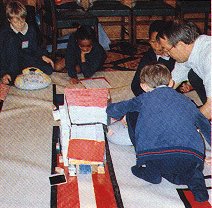 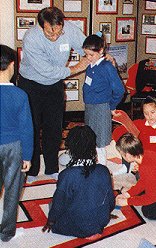 |
Meanwhile "Going Places" was really beginning to move (sorry about that) and we had started to design and make a large floor map, approximately 4m x 4m, drawn on the reverse side of some vinyl flooring. Teachers adapted the map of our immediate vicinity from the A to Z and made all turns/junctions a multiple of 30 degrees thus enabling the children to program the routes. This was then colour coded according to a land use survey we had already carried out.
We built a "photo map" by placing our photos in the correct place and model making was undertaken. Due to the large size of our map (once in the classroom you just about had room for the children but not the desks!) we were able to actually walk the routes. This proved to be crucial as even the less able children found it possible to translate the actual journey into a Roamer program. This emphasised the process of think, walk, measure and test. Pupils began to program Roamer using some of the stories they had already written. They discovered this was quite a complex process and involved much key pressing. They were beginning to reach frustration level when we were saved by the arrival of an interface which allowed us to "save" and "load" our programs to a Nimbus computer.
One of the most enjoyable activities which our children undertook was the design and construction of characters from their stories using Roamer jackets and a variety of found resources. Very often this collection of paraphernalia was attached by the judicious use of a glue gun. You will be pleased to hear it just pulls off! Some groups also began to investigate the use of lights as a practical extension of their science curriculum. The children went from strength to strength, but eventually time ran out on us and the big day arrived (motors and sensors will have to wait a while longer).
We took a selection of our work to the Council House in Birmingham. During the day we ran four workshops, using our map and other resources, where our pupils were given the opportunity to present the Primary Technological Curriculum to other spheres of education. It was both fascinating and fulfilling watching nine year olds explain their work to Secondary age children, teachers and elected members. Most people who saw the exhibition of work and took part in our workshop appeared to enjoy themselves, but not as much as the pupils from Kings Rise who were truly impressed by the lunch at the Council House - particularly when they realised that they were able to help themselves!
This is just the start of the Kings Rise Roamer Journey and, if asked, we will be only too pleased to keep you abreast of future developments.
Many thanks are due to Sue Dorricott; Tony Jackson and Gay Jones who all made valuable contributions to this project. Thanks are also due to Valiant who have provided fantastic support particularly when we were requesting equipment which was not currently available. I don't know how they managed it, but somehow it always appeared!
| Back |
|---|